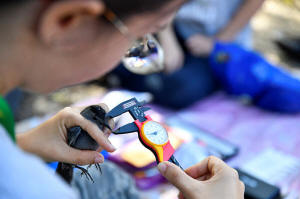No visa required: Cuban biologists unravel mysteries of bird migration
 Send a link to a friend
Send a link to a friend
 [February 16, 2024]
By Dave Sherwood and Alien Fernandez [February 16, 2024]
By Dave Sherwood and Alien Fernandez
HAVANA (Reuters) - University of Havana professor Daniela Ventura has
intercepted a migrant.
Her net, stretched taut on a forest trail in Havana's Botanical Garden,
trembles. A catbird - a discretely clad gray bird with a black cap -
thrashes then succumbs as she plucks it from the net's near invisible
webbing.
Ventura calls out observations to her students who take notes nearby -
species, weight, an estimate of the bird's body fat. They are fresh data
points in a project that aims to unravel mysteries into how and where
migratory birds from the United States and Canada spend their winters in
Cuba.
"We know a lot about their ecology in the breeding zone (in North
America) but very little about what happens in their wintering zone,"
Ventura said in an interview.
Part of the problem is politics, said Lourdes Mugica, an ornithologist
who helped to organize the research.
A U.S. Cold War-era embargo, which restricts trade and financial
transactions on the Caribbean island, has long complicated cooperation -
even in science - between the U.S. and Cuba. The birds, though, are
indifferent, Mugica said.

"Birds don't understand embargoes or geographic borders, they don't need
a visa to enter our country," she said. "I hope there comes a time when
relations are normal and that we can have joint projects between (the
U.S. and Cuba)."
Mugica and Martin Acosta, pioneering ornithologists in Cuba, say this
project - with partnership from Environment and Climate Change Canada -
hints at what is possible.
Together, the Canadian and Cuban partners have installed a radio
telemetry antenna - Cuba's first under an international tracking program
called MOTUS - which follows birds radio-tagged in other parts of North
America.
[to top of second column]
|

University of Havana professor Daniela Ventura takes beak
measurements of a catbird, affixed with an identifying leg band, at
Havana's Botanical Garden, in Havana, Cuba, February 9, 2024.
REUTERS/Norlys Perez/ File photo

The antenna recently detected in Cuba a tiny Swainson's thrush,
first tagged in British Columbia, Canada, a voyage of 5,000 km
(3,100 mi).
"We never though we'd reach the level of sophistication we now
enjoy," said Acosta.
Mugica and Acosta recall hard days during their careers - Mugica
said she lost 70 pounds (32 kg) doing research decades ago, at a
time when food in Cuba was scarce.
Logistics remain an issue even today. The scientists' 20-year-old
pick-up truck needed a push start on a recent morning.
But the team celebrates small victories.
The catbird ensnared in the mist net had been captured and affixed
with an identifying leg band back in November at the same site,
Ventura's data showed. It had gained body fat in the three months
since, she said, ahead of its coming migration north across the Gulf
of Mexico.
"To think these little birds, which weigh less than 10 grams (0.35
oz), cross the sea and come back and survive is spectacular," she
said. "It's humbling ...to think that other living beings can
perform these feats."
(Reporting by Dave Sherwood and Alien Fernandez, additional
reporting by Carlos Carrillo; Editing by Rosalba O'Brien)
[© 2024 Thomson Reuters. All rights reserved.]This material
may not be published, broadcast, rewritten or redistributed.
Thompson Reuters is solely responsible for this content. |